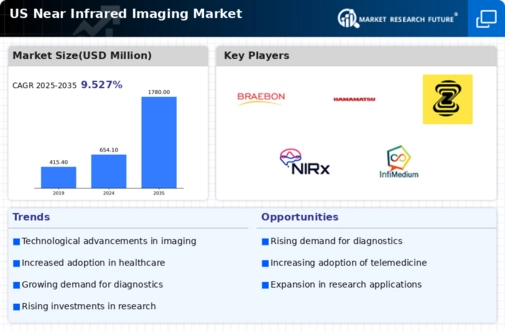Rising Demand for Non-Invasive Techniques
The near infrared-imaging market is experiencing a notable increase in demand for non-invasive diagnostic techniques. This trend is largely driven by the growing awareness among healthcare professionals and patients regarding the benefits of non-invasive procedures. As a result, the market is projected to expand significantly, with estimates suggesting a growth rate of approximately 15% annually over the next five years. This shift towards non-invasive imaging methods is particularly evident in fields such as oncology and cardiology, where early detection and monitoring are crucial. The near infrared-imaging market is thus positioned to benefit from this rising demand, as it offers innovative solutions that align with the preferences of both practitioners and patients.
Growing Awareness of Early Disease Detection
There is a growing awareness of the importance of early disease detection, which is significantly impacting the near infrared-imaging market. As healthcare providers and patients increasingly recognize the benefits of early diagnosis, the demand for advanced imaging technologies is expected to rise. This trend is particularly relevant in the context of chronic diseases, where timely intervention can lead to better patient outcomes. The near infrared-imaging market is poised to capitalize on this awareness, as its technologies offer non-invasive and efficient methods for detecting various health conditions. This shift in focus towards preventive healthcare is likely to drive market growth in the coming years.
Expansion of Research and Development Activities
Investment in research and development (R&D) within the near infrared-imaging market is on the rise, as companies seek to innovate and enhance their product offerings. This focus on R&D is driven by the need to improve imaging technologies and develop new applications across various sectors, including healthcare and agriculture. Recent data indicates that R&D expenditures in the imaging sector have increased by over 20% in the past two years, reflecting a commitment to advancing imaging capabilities. The near infrared-imaging market stands to gain from these advancements, as new technologies can lead to improved accuracy, efficiency, and a broader range of applications, ultimately driving market growth.
Increased Funding for Medical Imaging Technologies
The near infrared-imaging market is benefiting from increased funding directed towards medical imaging technologies. Government initiatives and private investments are playing a crucial role in supporting the development and commercialization of advanced imaging solutions. For instance, recent funding programs have allocated over $100 million to enhance imaging technologies, which includes near infrared applications. This influx of capital is expected to accelerate innovation and expand the market's reach within the healthcare sector. As a result, the near infrared-imaging market is likely to see a surge in new product launches and enhanced imaging capabilities, further solidifying its position in the medical imaging landscape.
Integration of Artificial Intelligence in Imaging Solutions
The integration of artificial intelligence (AI) into imaging solutions is emerging as a transformative driver for the near infrared-imaging market. AI technologies are being utilized to enhance image analysis, improve diagnostic accuracy, and streamline workflows in medical settings. Recent studies suggest that AI can increase the efficiency of imaging processes by up to 30%, thereby reducing the time required for diagnosis. This technological advancement is attracting interest from healthcare providers seeking to optimize their imaging capabilities. The near infrared-imaging market is thus likely to benefit from the incorporation of AI, as it not only enhances the quality of imaging but also supports the growing demand for rapid and accurate diagnostic solutions.
















Leave a Comment